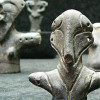
The Earth Fertility of old Europe
within World’s Black Archeological Market Art, Education, Symbols and Signs, default#goddess of old Europe #art and World’s Black Archeological Market
Neolithic European wisdom, symbols and divine learning from
Marija GIMBUTAS Earth Fertility of old Europe
Symbols and Signs Research by Nataša Pantović
Ever since its first discovery in 1908 by the Serbian archaeologist Miloje Vasić, Vinča culture, a Neolithic settlement that spanned most of Serbia, parts of Romania, Bulgaria & Macedonia, has been of great interest to the lay public and scientists alike.
Middle Bronze Age Goddess 1800 BC
From Neolithic monuments to Roman Villas and prehistoric figurines the river basin of Danube (Serbia, Romania, Bulgaria) has proved rich for treasure hunters over the years
In 2005, Police in central Germany found the artifacts that date to the Neolithic period and are believed to belong to the Vinca, in a sports bag belonging to two Serbs. Last year, a 2,000 year old Roman monument weighing half a ton was stolen in 24 hours after the find. Such epigraphic monuments, stone monuments with Latin engraving text) are extremely rare in the world so the value is extremely high.
Check also Neolithic Europe Vincha Symbolism of Bull in Early Neolithics
With 100s of objects discovered, Serbia would ranke among the first in Europe for finds declared if there is not a huge Archeological Black Market that leads these priceless artifacts into foreign private hands. If you're into stats, there’s every chance with every new dig unearth more hugely significant finds. The found and stolen monument on the territory of Serbia is unique in the world because they are highly preserved with Latin (Greek) inscription in 15 lines. Based on the inscription on the monument, an expert from the National Museum found that the monument belonged to a chivalrous man. He commanded various military departments and took part in the war with the Dacians and Parthians. The special value of this monument for Serbia and Belgrade was in the fact that it was found in its original place: the ancient Singidunum.
Now Information about the monument is included in the Interpol database of stolen archaeological items so that thieves can never sell it to a museum but still it goes to someelse’s hands.
Neolithic Wisdom from Ancient Temples, Maltese Temples to Greek Parthenon or Babylon Mysticism
Vinča European Civilization
Research and analysis of the artifacts, remains of houses, show a civilization that was so advance to have insulation against the elements, multi-room layouts, even public communal spaces. Divided by streets, enclosed by ditches discovered all over Serbia in numberous archeologiical sites.
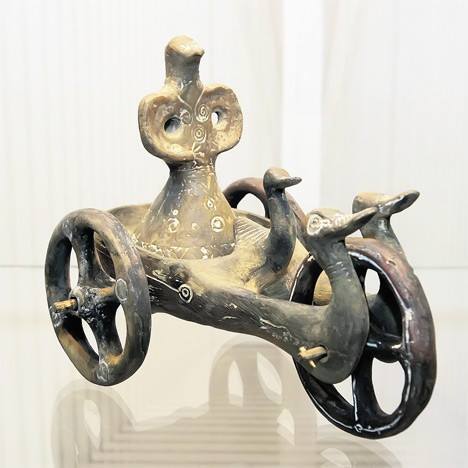
The 3500 year old Dupljaja Chariot Serbia National Museum Belgrade Archaeology
The sheer number of objects found at the Vinča sites, suggest an ancient export or ancient industrial production. In its times of plenty the Vinča culture’s scientists have developed metallurgy. “There is a wider flow of people and ideas in a larger geographic area. Obsidian from the Carpathian mountains, shells from the Aegean and Black seas, axes from the rare Alpine rock nephrite, and the salt trade is also confirmed,” Dr Petrović says about the flow of people and goods. This period of Vinča history shows trading connections with other parts of Europe as metal objects began to be exported from Vinča.
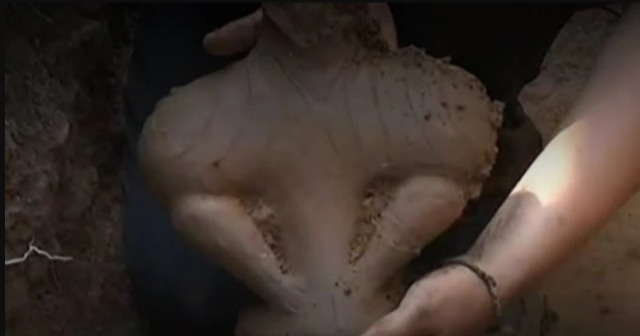
Župa Goddess 6000 years old Vinča Serbia
Last year, archaeologists led by Sanja Crnobrnja Krasić found a most amazing 6,000-year-old monumental figurine representing a fertility goddess named „Venus of Župa“. „This discovery proves our assumption that Vitkovo was a religious centre of the Vinča culture, because the Venus figurine is tall more than 30 centimeters."
What was worshiping of Goddess in Ancient Europe?
Quotes DIALOGUES D'HISTOIRE ANCIENNE, Marija GIMBUTAS
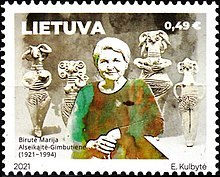
Marija Gimbutas 2021 stamp of Lithuania
Marija Gimbutas (1921 – 1994) was a Lithuanian archeologist known for her research into the Neolithic and Bronze Age cultures of Old Eurlope.
During the 1950s and early 1960s, Gimbutas earned a reputation as a world-class specialist on Bronze Age Europe, she directed major excavations of Neolithic sites in southeastern Europe including Anzabegovo, near Štip, Republic of Macedonia, and Sitagroi in Thessaly (Greece). In her work she reinterpreted European prehistory and challenged many traditional assumptions about the beginnings of European civilization.
As a Professor of European Archaeology and Indo-European Studies she unearthed a great number of artifacts which she researched and documented throughout her career.
Marija Gimbutas Goddess Quotes:
„Fertility is not a primary function of the prehistoric Goddess Creatrix and has nothing to do with sexuality.“
„The prehistoric Goddess of the Upper Palaeolithic and Neolithic essentially is a tri-functional goddess: Life-giver, Death, Death-wielder and Regenerator.“
„To the first function belong such images as the anthropomorphic and zoomorphic (deer, bear) Giver of Birth, Cosmic Creatrix and Giver-of-All in the form of water fowl and water fowl-woman hybrids and serpent woman, as well as protectresses of young life (Nurse and Madonna images)“
„death and regeneration (the two are closely linked), belong the Vulture - Owl- and other Bird of Prey-Goddesses, anthropomorphic Stiff Nude, bone phalange, triangle and hourglass shapes (sometimes portrayed with bird's claws instead of human feet or hands”
“the Goddess as Regenerative Uterus in zoomorphic shapes (bucranium, fish, frog, hedgehog), and Rising Goddess as an insect (bee, butterfly) and a life column (tree, snake)”
„The moon's three phases - new, waxing, and old - are repeated in trinities or triple-functional deities that recall moon phases : maiden, nymph, and crone; life-giving, death-giving, and transformational; rising, dying, and self-renewing. Life-givers are also death-wielders. Immortality is secured through the innate forces of regeneration within Nature itself.“
Neolithic Stone Mini Sculpture Goddess figurine Serbian archaeological settlement 5000 BC - 10000 BC #Artifacts
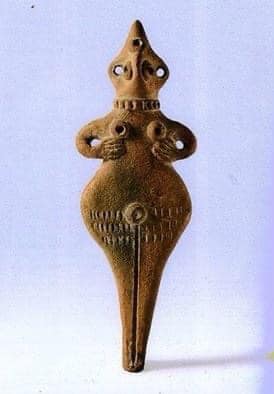
Neolithic Stone Mini Sculpture Goddess figurine Serbia
„The Pregnant Goddess is one of the stereotypes among the upper palaeolithic divine images repeatedly produced through time.”
“Good examples of this stereotype are known from Kostienki I in the Ukraine and from La Marche, Vienne, France. Kostienki sculptures may date from around 20,000 B.C.”
“Their breasts and buttocks are the focus of attention, not their bellies; they hold their hands on their breasts. The images we shall be concerned with here are of pregnant women holding their hands on their bellies.”
“In the Copper Age, the Pregnant Goddess remains one of the most revered divine characters : She is the only one portrayed enthroned in a regal posture; her bulging belly and other generous body parts are marked by squares, triangles, snake coil spirals, and the numbers two and four.”
The Earth Fertility or Grain Goddess and her double, the sow, dates to the 7th millennium B.C.
“The sacred animal of the Pregnant Goddess is the sow.”
“Individual sow masks of exquisite workmanship, probably cult paraphernalia, are known from the Vinca and Karanovo cultures, and the importance of the sow in cult practice is suggested by the considerable numbers of sow effigies and pig-shaped vases with lids in the shape of a pig's head. Sculptures and vases of sows are known from the end of the 7th to the 3rd millennia B.C. and later.
“The lozenge and triangle with one or more dots are encountered on shrine walls, vases, seals, and typically on the pregnant belly or other parts of the Pregnant Goddess, starting in the 7th millennium B.C”
“If the head is shown, it is cylindrical and wears a mask, which is not beaked but human, with a normal mouth. Removable masks as found at Achilleion II and IV (c. 6300-5900 B.C.) probably belong to the same Goddess.”
Placing Goddess Figurines within Houses
“In Old European settlements, figurines of this type are located on a platform near the oven or other area of grain preparation, and under the floor, whereas the Bird Goddess is characteristically found inside house shrines. The earliest evidence for this distribution comes from the Achilleion mound, c. 6500-5600 B.C., Thessaly, northern Greece (author's excavation; Gimbutas 1988).”
“In several instances, enthroned figurines of the 5th millennium B.C. are found in hidden alcoves or pits beneath dwelling floors “
European Cross – or sowing in four directions.
“The lozenge with a dot in the four corners may denote planting "in all four directions", a concept still extant in European folk belief. Throughout Europe, sowing in four directions is a ceremony carried out at the winter and spring plantings to ensure that dead vegetation will come to life again.“
“The ritual find, assigned to the Cucuteni Bl phase (Cucos 1973), consists of six painted vases arranged in a circle around a large vessel intentionally placed over an egg-shaped, lidded vase. At the base of the vase, four figurines had been placed at the cardinal points. Two were unpainted but bore faint traces of red ochre; the heads and feet of the other pair were painted black, and the bodies carried an overall parallel line pattern.
“Greece, pots with corn seeds kept near the hearth in the house symbolized the dead who rest in the womb (pot) and are resurrected in the spring. The dead were called "Demetrioi", those who belong to Demeter, the Grain Mother, and who rest, like the corn, in the womb of that goddess.”
“Traditionally, three and nine (three times three) were magical numbers used to invoke increase and multiplication.”
Sacred Bread from Banjica 3500 BC
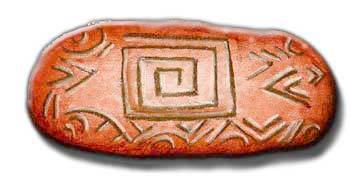
Sacred Bread from Banjica 3500 BC
“The clay model - about 15 cm. long and marked with lozenges and spirals - which was discovered at Potporanj, a Vinca site in eastern Yugoslavia, is clearly such a loaf. Another, marked with a meander encircled by inscriptions, was found at Banjica near Belgrade (Todorovic and Cermanovic 1961: Table XIIÍ, 5).”
“The bread oven was the principal feature of Old European temples. Some miniature shrine models, such as the one from Popudnia in the western Ukraine, contain one or more figurines engaged in the baking activities of grinding grain and preparing dough. The inner walls of the model are painted with a multiple lozenge design, clearly linking the shrine with figurines so marked. Bread prepared in a temple was sacred bread, dedicated to a Goddess and used in her rituals.
In later antiquity, bread and cakes for religious purposes were baked in various shapes - loaf, snake, bird, animal, flower - or had an impressed design. There is no doubt that this custom is neolithic in origin, and it is highly probable that neolithic seals with various raised or incised symbols were to stamp the appropriate design on the breads and cakes assigned to a particular Goddess.”
Sacred hills
“This symbol - a hill - shaped figure with a small knob at the top – is repeated in an engraving on a slab at the beginning of the passage.”
“Sacred hills were venerated in history up to the 20th century. The worship of the Earth Mother was celebrated on mountain summits crowned with large stones. Such practices are recorted for both Minoan and modern Crete in the south, the British Isles in the west, and the East Baltic area in the east, in various historical periods. In Germany and the Scandinavian countries, flat stones with polished surfaces are widely known as Brautsteine, or bridestones.”
Large Stones as Goddesses
“Large stones with flat surfaces dedicated to Ops Consiua, a Roman Goddess of Earth Fertility, were kept in holes in the ground (sub terra) covered with straw. They were uncovered only once a year during a harvest feast (Dumézil 1969 : 293-296). About 1500 years later, the same tradition is recorded in northern Europe. In Lithuania, the Jesuit annals of 1600 A.D. describe large stones with flat surfaces dug into the earth and covered with straw; they were called Deyves , "Goddesses" (Annuae Litterae ) Societatis Jesii , anni 1600 ; cited by Greimas 1979 : 215). Thus we learn that the stone is the Goddess herself.”
Primordial Womb and Red
“The caves, crevices, and caverns of the earth are natural manifestations of the primordial womb of the Mother. This idea is not neolithic in origin; it goes back to the Palaeolithic, when the narrow passages, oval-shaped areas, clefts, and small cavities of caves are marked or painted entirely in red (Leroi-Gourhan 1967 :174). This red color must have symbolized the color of the Mother's regenerative organs. In southern and southeastern Europe, neolithic graves were oval in shape, symbolic of an egg or womb.”
Number Two and Goddess, Vinca twins is a female figurine from the culture of Old Europe Vinča.
Archaeological finds in Vinča since 2021 including incredible stone statues used for Neolithic rituals and burials go back to 4,000 BC. The Twins, belonging to the Vinca settlement, was unearthed in what is now the area's Heritage Park and dates back 5,200 years.
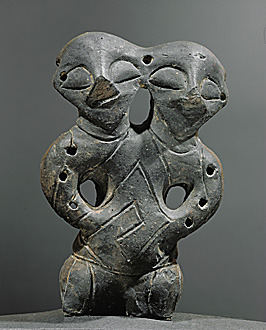
Vinča Statue Twins 3200 BC Symbolism of Number 2
Since Ancient Europeans followed the river Danube of north Serbia numerous generations of humans have made the county their home and left behind intriguing artefacts for 21st century archeologists to discover. The statues dug up by the Serbian and International researchers would not have been touched by humans for thousands of years and offer a fascinating insight into ancient Europe’s rituals, and development of thought.
Number Two as the repetition that brings plenty or a philosophical concept later developed by Pythogoras and Neo-Platonists Numbers…
“The rock-cut tombs and hypogea of Malta, Sicily, and Sardinia are usually uterine, egg-shaped, or roughly anthropomorphic. In western Europe, where large stones were used in grave architecture, the body of the Goddess is magnificently "cruciform" and realized "double-oval" as the megalithic tombs tomb. are unmistakably The so-called human-shaped. The stone temples of Malta share the same contours as terracotta and stone figurines of the Goddess.”
Check Goddess Worship and 111 HZ
“The twin or seasonal (mother-daughter, summer-winter) aspect of the Goddess very probably is also expressed by the double temples of Malta such at Ggantija and Mnajdra”
“Four other vases are decorated with the egg and seed symbol flanked by snake spirals. The design on the eight vases is remarkable for its thematic unity and the use of the traditional "power of two" device - repetition - in the conventional way to express (and to invoke) fertility.“
Sacred holes in Temples
“partition walls sometimes have round holes. Such holes are also present in Maltese temples. Their meaning is apparent if the still-extant veneration of stones with holes is considered. Belief in the miraculous power of holed stones occurs in Ireland, Scotland, England, France, and in many other European countries. Crawling through an aperture of a sacred stone brought regeneration; diseases and sins were discarded.”
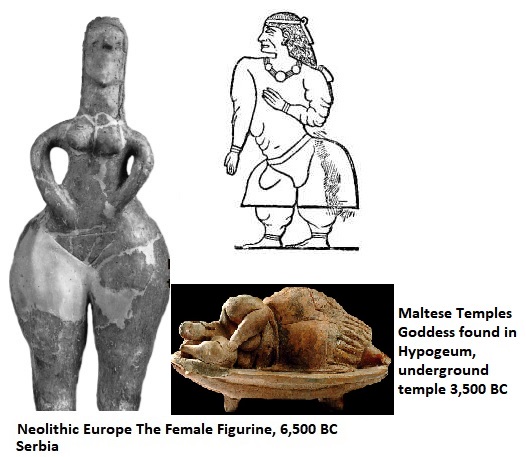
Neolithic Europe 6500-bc Donja Branjevina Serbia, Maltese Sleeping Lady and Egyptian Eli
“Buttocks were also portrayed in that most precious material, gold. Gold-plated amulets in the shape of buttocks and buttocks in repoussée or punctated line on gold plate are known from Copper Age Hungary and Romania. Similar intensification can be seen in energy symbols - whirls and double snake spirals - on the egg-shaped buttocks of figurines from the Karanovo, Cucuteni, and Vinca groups.”






The Earth Fertility of old Europe No comments on The Earth Fertility of old Europe: